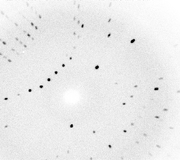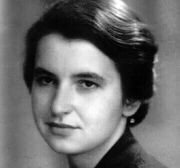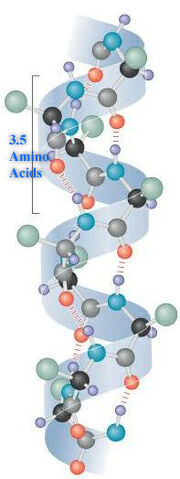An Alternative History of the Discovery of the Structure of DNA.
Can you spot how this story diverges from reality?

James Dewey Watson (born 1928)
James Watson started college at the age of 15 and had completed his PhD research at the age of 23. While an undergraduate he shifted his interest from ornithology to molecular biology. Some parts of Biology were making a transition from the era of classical biology to the new age of molecular biology. Watson faced the challenge of trying to get a chance to join a research laboratory that would bring him closer to his goal of learning the physical basis of heredity.

Diagram of a bacteriophage.
A number of scientific specialties were converging on this goal: genetics, biochemistry, biophysics. Watson’s PhD research involved a genetic approach, making use of physical techniques to probe the properties of viruses. The viruses he worked with were the smallest known genetic agents; agents that some scientists thought of as comprising “naked genes”. For his post-doctoral research, Watson moved on to join a laboratory in Europe that studied the chemical components of DNA and the chemistry of nucleic acids. Another major approach to DNA, X-ray diffraction studies, he would soon learn about, too.
Cold Spring Harbor[]

Cold Spring Harbor Laboratory
Just before leaving for Europe and his post-doctoral research, Watson spent time at the Cold Spring Harbor laboratories on Long Island, New York. Watson learned about experiments being attempted to determine the identity of the molecule that carried genetic instructions. The choices had been narrowed to protein and DNA. The type of virus Watson had studied contained both protein and DNA. In the late 1940s, at the start of the nuclear age, radioactive isotopes were starting to be used as probes of biological molecules. DNA contains phosphorus while protein contains sulfur. Attempts were being made to radioactively label the molecular components of viruses and determine which one was inserted into infected cells in order to carry the viral genes inside where they could instruct the infected cell to make new viruses.
Arriving in Europe, Watson was able to participate in such experiments, but it would be another lab that stumbled upon the technical trick needed to make this type of experiment work. Such an experiment, motivated by electron microscopy, made possible by biochemistry and involving radioactive isotopes, bacteria and viruses was typical of the emerging field of molecular biology. Physics really was making itself felt in biology. Watson was eager to learn everything that was needed to reveal the secrets of genes and inheritance.

During the Classical Age of Biology Gregor Mendel found rules for the inheritance of physical characteristics of pea plants (such as flower color).
In the “classical age” of biological research there was little impact of physics upon the naturalists who made their observations of living organisms. Some of the impact of physics in the early days of biology was negative. When Charles Darwin argued that biological change had taken place over the course of many hundreds of millions of years, physicists like William Thomson claimed to be able to refute the idea by “showing” that such extreme age was contradicted by physical data. Of course, Darwin was right and new physical processes like radioactivity were discovered that allowed careful determination of the great age of the Earth. The confidence of physicists is often impenetrable, regardless of whether they know what they are talking about, and they often inflict their sense of superiority and infallibility upon scientists in other disciplines like biology.

Does human experience reveal reality or just a shadow of Ideal Forms?
Mathematics plays a special role in physics that shapes the entire approach that many physicists take towards scientific discovery. Some physicists have even found it puzzling that it should be possible for people to understand the nature of the world we find ourselves in. Albert Einstein said, "The eternal mystery of the world is its comprehensibility." Much of this kind of puzzlement arises from the murky depths of the Platonic dualism that has dominated Western mathematics and physical science. It is all too easy for mathematically inclined physicists to imagine that there are Two Worlds rather than one. Plato imagined both the familiar world of personal experience arising from the human senses and a second world of Perfect Ideal Forms. Philosophers have often imagined that we have a mental faculty that allows us access to knowledge about the Ideal Forms. Some philosophers have gone to the extreme of suggesting that science is a way to discover the world of Ideal Forms, denigrating the world we know through personal experience to a deceptive fog that we must learn to see past. If mathematics is the language of the Ideal Forms, it can seem mysterious: why does mathematics also do so well to explain the non-ideal world? Of course, if there is only one world, then the mystery of comprehensibility evaporates. We can view mathematics as an invention of minds and we can make use of mathematics as just one of many tools that help us identify regularities and patterns in the world. There are also non-mathematical ways of finding patterns. As primates, our brains make it easy for us to visually identify many patterns in the world. Some scientists revel in mathematics and make use of it as much as possible. Others tend to avoid the use of mathematics as much as possible.

An X-ray diffraction image for the protein myoglobin.
Nature played a mean trick on us. The human visual system is adapted to dealing with bananas not the structure of the molecules that make life possible. The tool that finally allowed the structure of DNA to be revealed (X-ray diffraction) did not directly convert the submicroscopic shape of the DNA molecule into a macroscopic three dimensional model that we can view and understand. X-ray diffraction did produce visual results –dots on film- but the configuration of these dots was not easily related to the spatial array of atoms in the DNA molecule. Transforming the raw data into an understandable molecular model required careful interpretation of the raw data and it required mathematical analysis.

Rosalind Elsie Franklin (born 1920
During the discovery of the structure of DNA, some of the discoverers made heavy use of mathematics while one, Jim Watson, made a major contribution by using his built-in visual pattern recognition system. We can wonder why some scientists are more captivated by mathematics than others. Many budding physicists gravitate towards physics because of a natural affinity with numbers and calculation that they display early in life. Many budding biologists gravitate towards biology as a refuge from mathematics. Discovery of the structure of DNA required mathematically inclined scientists. Rosalind Franklin showed an early interest in numbers and made her way into scientific specialties that required mathematics. Watson made a key discovery by making use of good old ape visual imagination and the human ability to visualize how things like sticks and holes fit together and can be arranged relative to each other.

James Clerk Maxwell's equations that describe the unity of electromagnetism are an example of an important discovery that crystallized in one person's mind.
In some fields of human endeavor there are celebrations of the power of collaboration and the synergies that come from creative combinations of the talents of two different people. In the history of science, it is often the great flashes of insight by a single mind that have been celebrated. The physical sciences established this trend of expecting scientific breakthroughs to be the result of flashes of insight from one person’s imagination. As physics grew into a science, mathematical methods were applied to the most simple physical phenomena and often the individuals with access to critical data and knowledge of the required mathematics produced predictive mathematical models of a physical processes and were awarded credit for their “discoveries”.
When physicists have turned their attention to biological problems, the situation has often been different. The biological phenomena we observe around us have been built up and made complex by billions of years of biological evolution. Biologists train for years to acquire hard-won insights into this complexity, insights that have been slowly acquired by the science of biology. Within the social context of working biologists, these collectively held insights guide the search for new data and the interpretation of data that are in hand. Sometimes specialized physical scientists, trained as experts in the application of specific physical techniques, are drawn into biology research where they apply their methodological skills to a biological problem. It is useful for such people to collaborate with biologists so that the power of the physical methods can be adapted and efficiently applied to the biology. The lore of biology must be combined with technical know-how in order to get the most out of both.
James Watson and Rosalind Franklin were complementary in their skills and backgrounds. Watson, the biologist, was intent on rooting out fundamental secrets that hid in the darkness at the boundary between dead molecules and living cells. In particular, Watson wanted to understand the physical basis of genetics, how like begets like- what some have romantically called “the secret of life”. Franklin was a physical chemist and a wielder of a new tool, X-ray diffraction analysis of chemical materials. Watson and Franklin were destined to combine their talents and accomplish what would have been much more difficult for either working alone. Until the moment of discovery of the structure of DNA, nobody knew that the structure of DNA would so clearly reveal “the secret of life”. The beauty of the structure and its shocking biological implications make the discovery of the structure of DNA one of the most renowned events of scientific discovery. The interactions of the people involved in the discovery provide a powerful case study of the impact of human personal interactions on the process of scientific discovery.

Pauling and his colleagues discovered the protein alpha helix
Sometimes in science the elements of inspiration, intuition and technical proficiency required for discovery are both embodied in a single person. Linus Pauling provides an example. He was on a track parallel to Watson and Franklin and made fundamental progress towards sorting out the structure of proteins. Proteins are the busy beavers of cells and the other class of biologically important large molecules that along with nucleic acids were resistant to the methods of classical biochemists to reveal their secrets.

The protein alpha helix.
Pauling was of the older generation and had the time to assemble both the theoretical insights and the technical skills needed to discover the protein alpha helix. His accomplishment came at the apex of a career that had systematically first tackled the simplest biological molecules and then moved on to the complex molecules with growing confidence and a sense of inevitability. Scientists of the younger generation like Watson and Franklin found themselves facing the challenge of working to make a major scientific discovery while still learning their way in the world. This discovery of the structure of DNA came into the world with a feeling of shock and surprise rather than inevitability. As it turned out, the combined talents of a group of scientists that included Watson and Franklin came together to reveal the structure of DNA and create a dynamic human backdrop for the unveiling of “the secret of life”.
The pace of the discovery of the structure of DNA was different than the pace for protein. Each protein is a specialist with a baroque structure suited to its particular function. Pauling’s discovery was a regularity in protein structure that is common to many proteins, but much more work was needed after knowing about the alpha helix in order to understand the complete picture of any particular protein’s structure. In contrast, DNA has only one job, to hold genetic instructions, and the structure of DNA is correspondingly simple. The discovery of the structure of DNA would be a dramatic endpoint, uniting structure and function in one sudden revelation.
Two extremes can be distinguished in how scientists come to work on specific problems and topics. Sometimes a particular scientist is simply in the right place at the right time to adopt a particular research problem that is ripe and ready to be plucked. In such cases, no great thought and planning is involved. When the work on such a project is done, the researcher is free to move on to some other task. There is a chemical analogy for such jumping from project to project: the easily made and easily broken hydrogen bond. Rosalind Franklin was able to apply her technical skills to a series of problems in biology, sequentially moving from the study of coal to DNA to viruses during her short life.
[]
Continue to Chapter Two